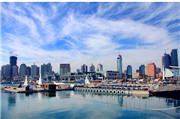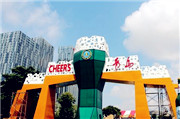Environment
( chinadaily.com.cn )
Updated: 2013-04-23
|
|||||||||
1. Ideal Location, Great Traffic Network, Competitive Advantages
Qingdao, in Shandong province, is one of the east coast's major cities, and an important provincial city, with a well-developed economy. It borders the Yellow Sea to the southeast, has the port city of Yantai to the northeast, Weifang to the west, and Rizhao to the southwest, with Japan, the Republic of Korea, and the DPRK a short distance across the sea to the northeast. Qingdao sits in a temperate zone with a mile monsoon climate and marine characteristics such as high humidity, good rainfall, agreeable temperatures, and four distinct seasons. Average annual temperature is 12.2 ℃, with August being the hottest month, at 25 ℃, and January, the coldest, being around 1.3 ℃. Average annual rainfall is 775.6 mm. Qingdao is a popular tourist destination with a unique location and interesting history, which make it a good place for sightseeing and recuperation. It was a summer resort as early as the 1920s and is now a model of environmental protection. Its typical European-style architecture is a common sight in the older parts. The coast and landscape combine Chinese and western elements and bring together the mountains, sea, and city with red roofs intermingled with green trees and azure sky, joining the blue sea. Large numbers of Chinese and foreign visitors descend on Qingdao for everything from sightseeing and leisure to business, conferences, and exhibitions. Qingdao has Liuting International Airport, with nearly 100 domestic air routes and 16 international and regional routes, four international passenger ship routes, and expressways that connect it to all major cities nationwide. It is also a famous shopping spot for Shandong and a mere one-hour flight away from the ROK and Japan, which gives it the initiative to develop newer models of commerce.
2. Economic and Developmental Vitality
Qingdao plays a specific role in State planning and has it owns economic administration on a par with the province's. It has six districts and four cities (county-level) under its jurisdiction, with an area of 10,654 square kilometers, and a population of 7.6 million (2.38 million in the city proper). In 2011, its GDP was 661.6 billion yuan, an 11.7-percent growth from the previous year, and a per capita GDP worth more than $11,000. General revenues of the local government were 56.6 billion yuan, a 25.1-percent increase. Its fivecounty-level cities ranked among China’s Top 100 (counties) in economic strength. The same year, its grain output reached 3.63 million tons, a record high, while vegetable, poultry, and aquatic product exports ranked among Chinese cities. Its annual agricultural product processing capacity was nearly 10 million tons. In addition, industrial output value was 1.26 trillion yuan, and the pre-tax profits totaled 114.6 billion yuan. Hi-tech industrial output value of enterprises reached 464 billion yuan, accounting for 39 percent of total industrial output value, while the output value of strategic new industries was 219.2 billion yuan, or 10.1 percent of total industrial output value. Also, by the end of 2011, Chinese and foreign currency deposits in financial institutions reached 890.1 billion yuan, the loan balance stood at 749.5 billion yuan, annual revenues from premiums reached 14.6 billion yuan, and finance industry added value accounted for 10 percent of the service industry total. Qingdao is an important international port, which was established in 1892, and a marine transportation hub for the western Pacific Ocean, with trade relations with 450 ports in more than 130 countries and regions. It has the world’s largest container dock that can handle ships with 15,000 standard containers, an ore dock that can accommodate 300,000-ton super ships, a crude oil dock, and a coal dock for 100,000-ton ships. In 2011, it handled 380 million tons of cargo (270 million tons from foreign trade), and 13.02 million standard containers. Its Liuting International Airport is at the 4E standard and has 107 airlines to more than 50 Chinese cities, and 12 international passenger and cargo airlines to Tokyo, Japan, Seoul, So Korea, Paris, France, and Hong Kong and Taiwan. In 2011, it handled 11.72 million passengers and 167,000 tons of cargo and mail, as well as more than 50 million tourists, 1.16 million of them from overseas. Total tourism revenues reached 68.1 billion yuan and Qingdao ranked among the Top 10 tourist destinations , the most loved city for young travelers in China, and the most dynamic leisure city in China. It established a system of sustainable economic development and became an economic center and one of the country’s cities with the most vitality. These things together provide a good economic foundation for shopping center and other development.
3. Ideal environment for commercial development, investment, and business start-ups
Qingdao was one of the first cities in China to implement the opening-up policy and, in the field of commerce and the retail sector, it developed in leaps and bounds, as can be seen in the following: it introduced top foreign companies, with all of the 14 foreign retailers being either members of the Fortune 500 or prominent transnational companies, including three of the top six Fortune 500 -- Wal-Mart, Carrefour, and Metro. Qingdao ranks top among the top 15 cities in foreign commerce and these foreign businesses grew rapidly. Qingdao has sister-city relations or friendly, cooperative relations with 56 cities in foreign countries and more than 2,000 overseas trading companies or financial institutions have offices here. Pakistan’s Haier-Ruba Economic Zone was the first overseas economic and trade zone of its kind in China. In 2011, the total import and export trade was worth $71.3 billion, with exports exceeding $40 billion. It had foreign direct investment worth $3.6 billion US dollars, and 101 of the world’s Top 500 enterprises investing in Qingdao projects. Total foreign-contracted projects, labor cooperation, and design consultation amounted to $1.35 billion, up 25-precent year on year. And it provided an excellent environment for commercial development because, while it was attracting these Fortune 500 businesses, it placed an equal amount of importance on investment promotion and environmental development, for example, by providing one-stop services during preliminary project negotiations, all-round services during construction, and regular follow-up services. And this development and construction environment for new commercial is gradually maturing, as can be seen in its large shopping centers.
4. Beijing Olympic Games partnership brings great opportunities
Qingdao played host for the sailing event of the Beijing Olympics in 2008, which gave it better global exposure and brought in more development opportunities. With this in mind, it has big plans to expand its opening-up to attract more foreign capital. At the same time, it will introduce more innovative development concepts to transform itself into a modern, more global, eco-city suited to investment, start-up businesses and better living. This will secure its environment and conditions for developing large shopping centers long-term. In view of the direction China’s retail sector is headed in, and the nature of coastal tourist cities and central business centers, the emphasis will be on spreading the mall concept of fashion, modernity, and novelty. And, world famous department stores, boutiques, restaurants, and fashion centers will be introduced so that the future shopping centers will be characterized by scale, function, and theme. Meanwhile, the proportion of indoor entertainment, fitness, and recreation services will be increased, so Qingdao will become a famous center of tourism and shopping, world fashion, recreation and entertainment, delicacies, and sports and fitness.
5. Great market prospects for the new business model
Market analyses show that Qingdao is entering a new phase with a per capita GDP of $3,000, which is consistent with continuing, healthy development. Local markets are prosperous and the consumer strength is good, with dramatic changes taking place in local consumer habits and concepts. International experience indicates that both large shopping centers and small convenience (e.g. 7-11) or specialty stores will see rapid growth with a new consumer mode. Meanwhile, as regards convenience stores and specialty (exclusive) shops, three consumer groups have appeared -- young to middle-aged, between 16 and 35, a group with strong participation consciousness and are enthusiasm for novel, but popular items; next, proprietors and white-collar workers with medium to high income levels, who think a lot about about price and are driven by a fast life and long work hours, for a rapid, convenient consuming lifestyle; and a third group, based on tourist areas, expensive living areas, and universities.
6.Five municipal-level commerce centers provide space for top department store and specialty shop development
The Qingdao government has come up with a large-city development framework, with a "Trianglular layout, linear expansion, and cluster development", and has improved its "Two + three" municipal-level commercial centers and nine district-level commercial centers, on Zhongshan Rd and Hong Kong Middle Rd, and in Taidong, Licang, and Huangdao, with a lot of shopping spots created. As for the business types, the municipal-level mainly consists of large shopping centers and department stores, supplemented by large specialty stores, exclusive shops, and culture, restaurant and entertainment outlets; the district-level is mainly department stores and large supermarkets, supplemented by large specialty stores, exclusive shops, with culture, entertainment, and restaurants. Foreign businesses are encouraged to make their presence felt in urban areas that lack new commercial outlets to improve the pattern of commerce and provide a better shopping environment and to increase the space available for a new commercial model.




